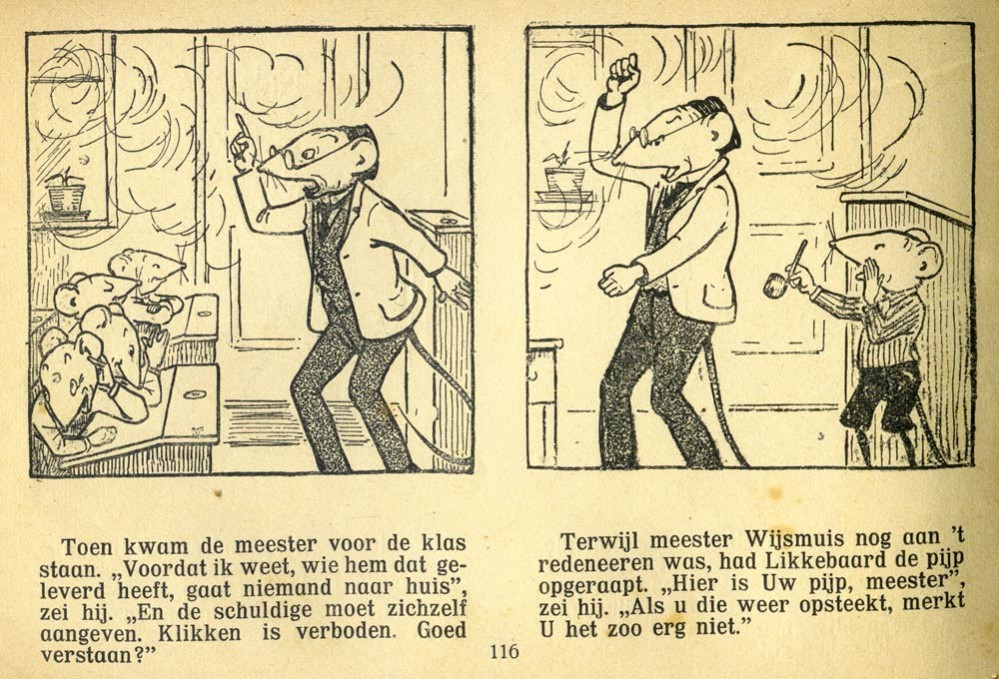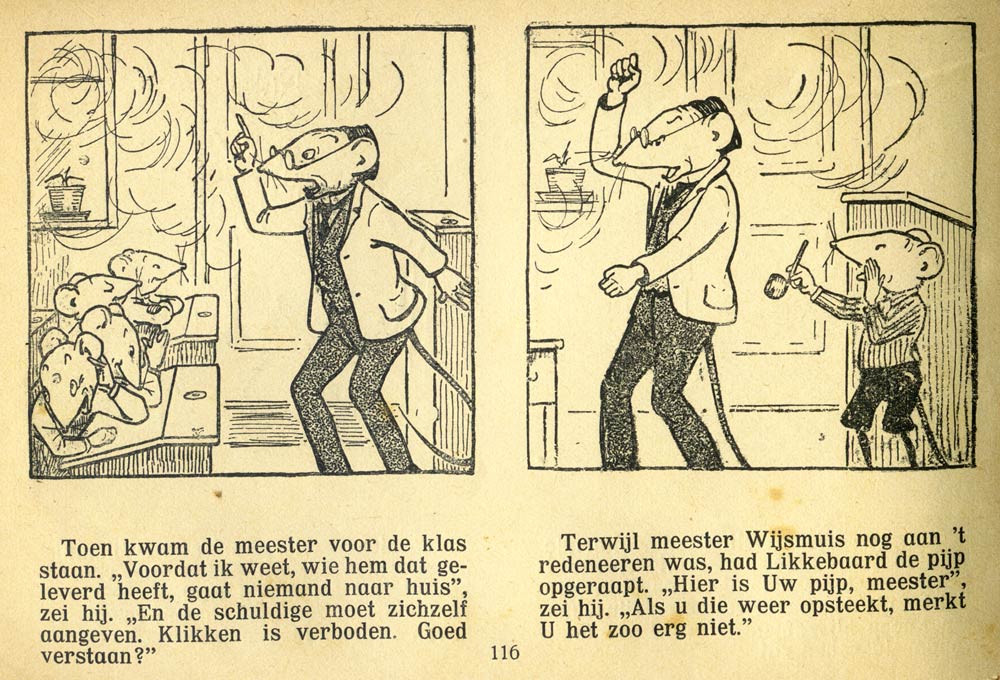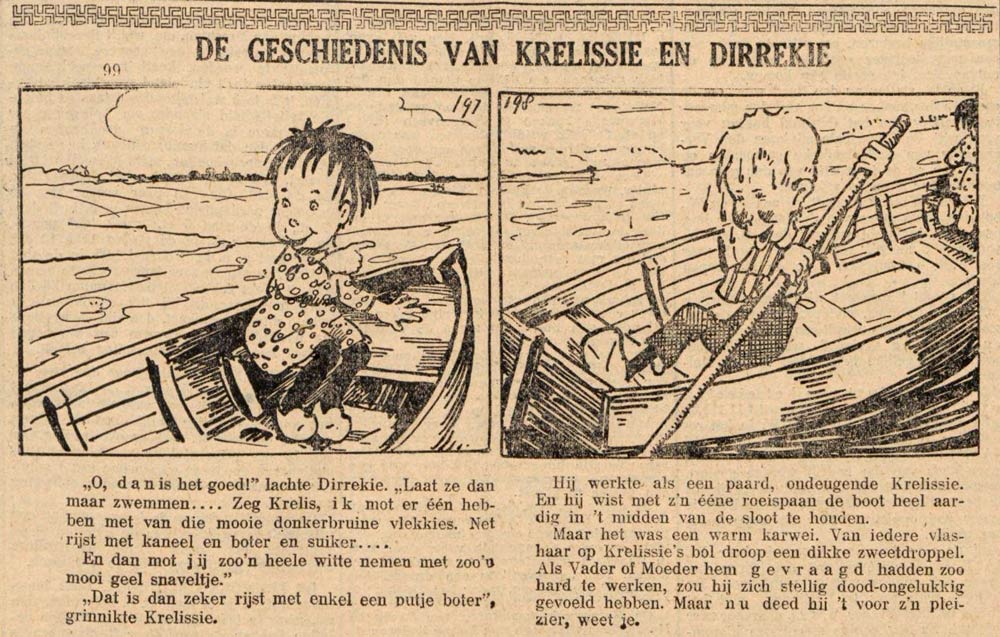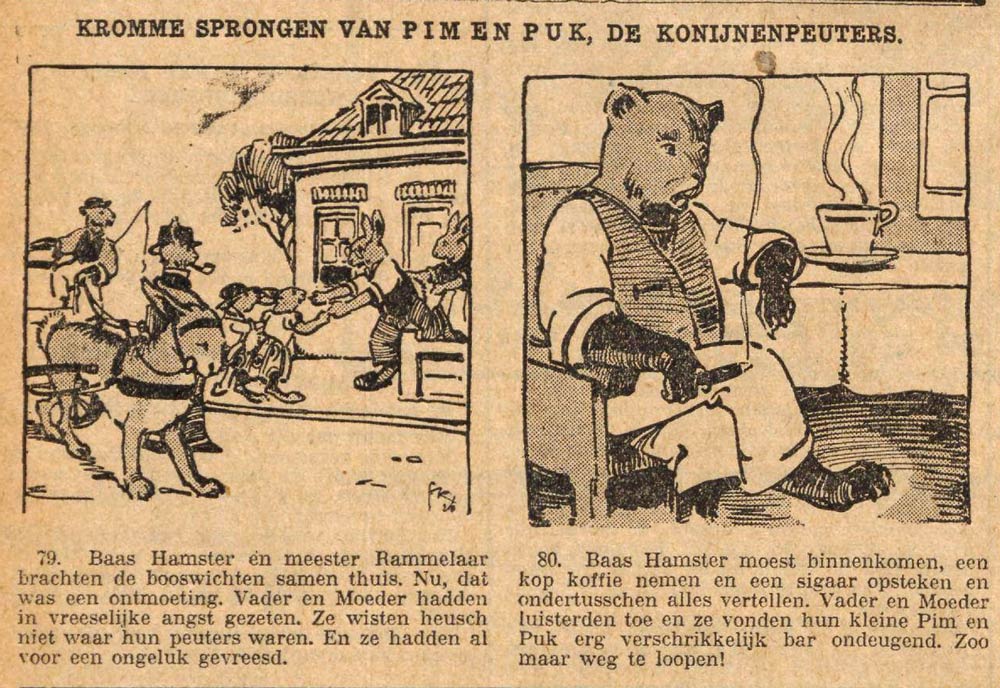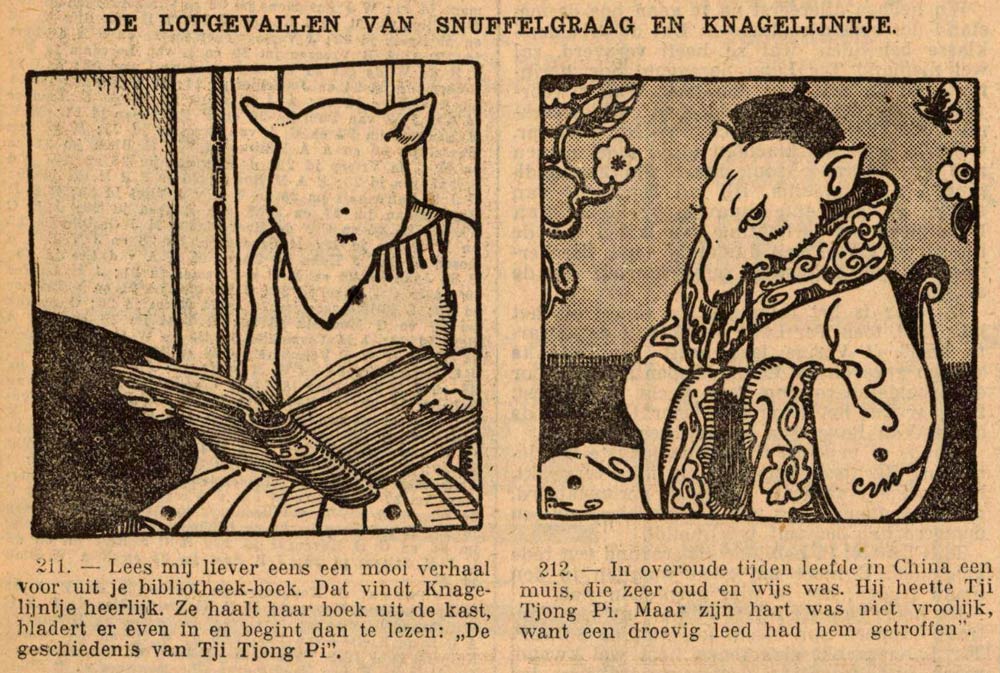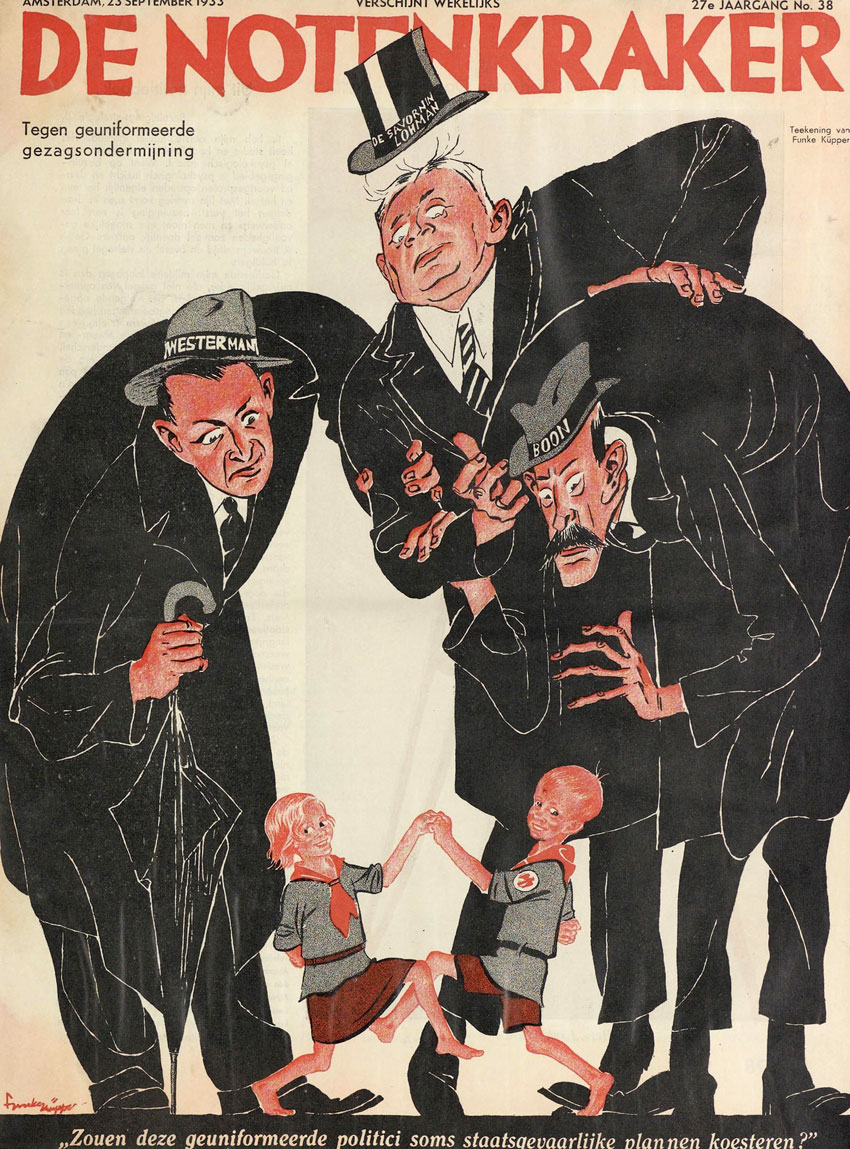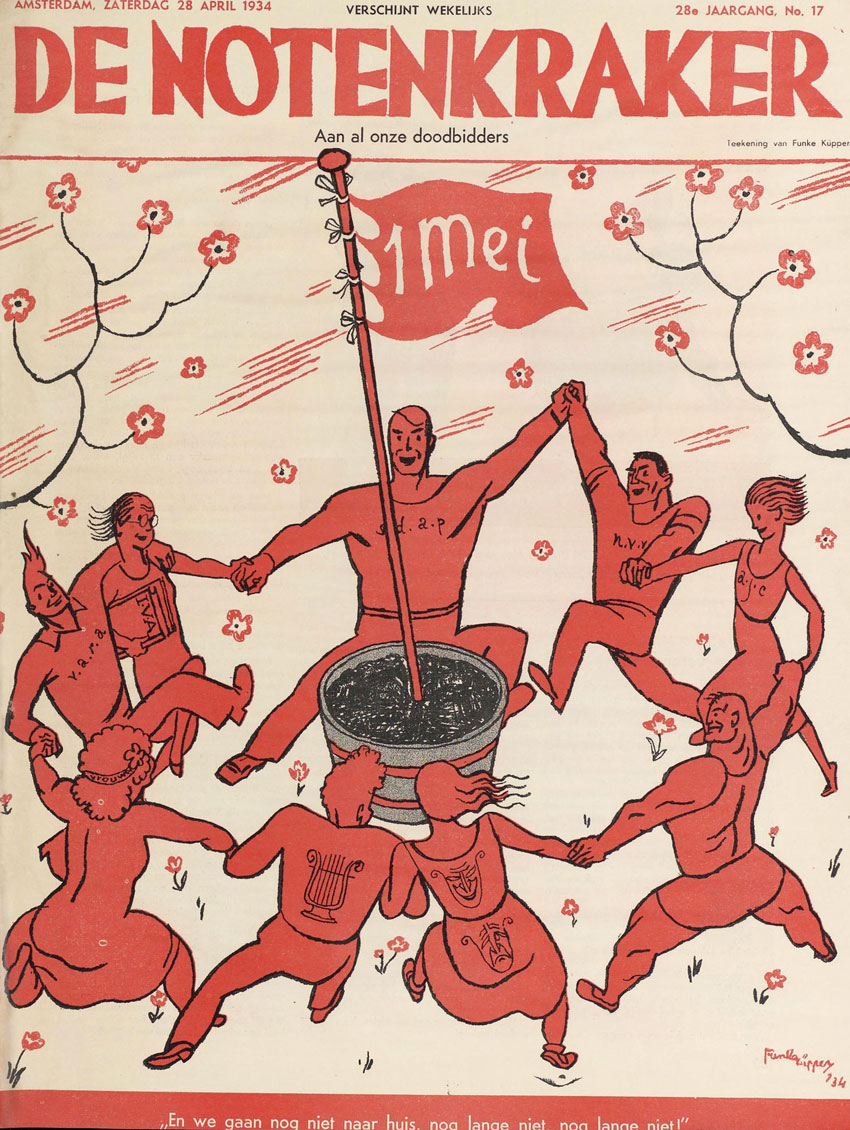'Snuffelgraag en Knagelijntje' (1929).
Albert Funke Küpper was a German-Dutch illustrator, comic artist, caricaturist and political cartoonist, working for socialist print media like Voorwaarts, Het Volk and De Notenkraker. A socially conscious man with a strong involvement in the early 20th century worker's movement, Funke Küpper made cartoons, illustrations and posters that criticized fascism and capitalism. As a comic artist with the social-democratic newspaper Voortwaarts, he made newspaper serials like 'Krelissie en Dirrekie' (1923-1924), 'Pim en Puk' (1926-1927), 'Dicky en Dirrekie Durf' (1928-1929) and 'Rodolfinus en Eleonora' (1934). Between 1927 and 1928, he continued Gerrit Rotman's newspaper strip 'Snuffelgraag en Knagelijntje'. Like most of the early newspaper comics in the Netherlands, Albert Funke Küpper's serials featured either typically Dutch farm children or funny animals, all presented in the text comics format.
Early life and career
Albert Johann Funke Küpper was born in 1894 in Ruhrort, Germany, as the son of a German father and Dutch mother. In 1895, his parents moved to Rotterdam, The Netherlands. Albert's father was the Westphalian painter Bernard Anton Funke Küpper (1869-1955), who passed on his artistic talents to his sons. After Albert came three sisters and two younger brothers, Theo Funke Küpper (1904-1977) and Frans Funke Küpper (1908-1993), who later also became illustrators and comic artists. In 1917, Albert Funke Küpper was naturalized as a Dutch citizen.
After receiving his certificates for primary education, drawing and gymnastics in 1912, Albert Funke Küpper began working as a public school teacher in Rotterdam. His teaching career was interrupted in 1914 by his mobilization in Katwijk - during this period he had much time to paint and draw - and by his studies at the Art Academies of Rotterdam and The Hague. In his spare time, he painted and drew traditional subjects in a realistic manner, but the sporadic exhibitions of his work did not receive much public attention. By the mid-1920s, Funke Küpper left his teaching job to pursue a career in drawing and painting. During his working life, Albert Funke Küpper made paintings, illustrations, picture stories, caricatures, etchings and political drawings.
'De Geschiedenis van Krelissie en Dirrekie', Voorwaarts, 7 July 1926.
Comics in Voorwaarts
During the 1920s, Albert Funke Küpper found employment with Voorwaarts, the Rotterdam newspaper of the Dutch Social Democratic Workers' Party, for which he made picture stories, political drawings and editorial illustrations. After the departure of Voorwaarts comic artist Henk Backer to another paper, Funke Küpper was asked to create a new children's comic serial. His first creation was 'De Geschiedenis van Krelissie en Dirrekie', about two farm children, a boy named Krelis and his sister Dirrekie. The comic ran in Voorwaarts from 31 October 1923 until 20 March 1924. Between 15 March 1926 and 4 July 1927, Voorwaarts ran Funke Küpper's next comic, 'Kromme Sprongen van Pim en Puk, de Konijnenpeuters', starring two little bunny rabbits. By then, Funke Küpper was also making his first political drawings for this newspaper.
'Pim en Puk, de Konijnenpeuters', Voorwaarts, 21 April 1926.
In 1927, another Voorwaarts cartoonist left, this time Gerrit Rotman, creator of the popular funny animal comic 'Snuffelgraag en Knagelijntje'. As the paper's staff artist, Albert Funke Küpper took over the feature, drawing over 1,600 pictures about the two little mice until the final episode on 18 October 1928. The text captions were written by journalist Arie Pleysier (1891-1980), who presumably also got Funke Küpper involved in the worker's movement and its ideals. The comic strip appeared in more than 20 other regional newspapers in the Netherlands, as well as a couple of foreign publications. During Funke Küpper's run on the strip, a couple of mice from other cultures were added to the cast, such as Tji Tjong Pi (a Chinese mouse), Ali ben Gejochte (an Arabic mouse) and Labbernoekas XXII (a black mouse).
Between 3 December 1928 and 1 August 1929, Voorwaarts printed another comic strip by Albert Funke Küpper and Arie Pleysier: 'De Wereldreis van Dicky en Dirrekie Durf', featuring two siblings making a world trip. After a five-year interlude, Funke Küpper and Pleysier teamed up again for another comic serial, 'Rodolfinus en Eleonora' (1934). After serialization in Voorwaarts, this story was published in book format too. The fairy tale story revolves around two dolls, Klaasje Vaak and Lang Dun en Lekker, who are abducted by Haaievel the witch. When they escape, they end up in a forest, where a group of gnomes mistake them for their king Rodolfinus and queen Eleonora.
'Snuffelgraag en Knagelijntje', Voorwaarts, 4 November 1927.
Socialist press
In the late 1920s, Funke Küpper left the Voorwaarts newspaper and headed for Amsterdam, where he was employed by the newly-founded socialist publishing company De Arbeiderspers. There, he was initially active as an illustrator for this publisher's book publications, but also as a political cartoonist for the socialist daily Het Volk. In many of his political cartoons, Funke Küpper showed a deep sympathy for the plight of the lower classes, especially children. As an illustrator-reporter, he often headed out with the journalists Arie Pleysier and Piet Bakker to make sketches of people, places and events.
Starting in 1927, Funke Küpper had replaced Leendert Jordaan as cartoonist in Het Volk's satirical weekly supplement De Notenkraker, edited by A.M. de Jong. In early 1933, he also joined the magazine's editorial team, where his creative ideas and vast knowledge of printing techniques came in handy. As one of the magazine's driving forces, Funke Küpper made many anti-fascist cartoons, several appearing in the cover. He was known for his clever caricatures of politicians with subtle humor. Among the other prominent cartoonists for the magazine at the time were George van Raemdonck, Tjerk Bottema and Albert Hahn Jr.
As his prominence within socialist circlces rose, Funke Küpper also received orders for posters, books and brochure covers from political parties, trade unions and related organizations. Other worker's magazines that printed his drawings were De Radiogids and Vrijheid, Arbeid, Brood!.
Final years and death
Besides being a cartoonist, Albert Funke Küpper was also a singer: in 1932, he sang the baritone during a performance in Essen of the oratorio 'Eines Menschen Lied' by Otto Siegel. On 23 November 1934, when on his way to the Paasheuvel camphouse of the worker's youth movement AJC, his car crashed into a train at an unguarded railway in Nunspeet. At age 40, Albert Funke Küpper was the first of his brothers to pass away. His body lay in state in Amsterdam, where thousands of friends and relatives of the labor movement paid their last respects. A funeral procession then left, via a guard of honor past the offices of De Arbeiderspers, towards the family grave in Katwijk. Speeches were given by representatives of his publishing house, the social-democratic worker's party SDAP, the NVV union and the socialist broadcasting organization VARA. Among his pallbearers were Notenkraker editor-in-chief A.M. de Jong and fellow cartoonist Jo Spier.
In 1935, De Arbeiderspers released a memorial book, 'In Memoriam Albert Funke Küpper', collecting 15 color and 160 black-and-white drawings. In the same year, a traveling exhibition of Albert Funke's work was organized, among other places at the Stedelijk Museum Amsterdam. Albert Funke Küpper's energy, involvement and unceasing productivity were such that De Notenkraker didn't last long after his untimely death. The final issue appeared in 1936.
In Amsterdam’s Osdorp neighborhood, the Funke Küpperstraat is named after Albert Funke Küpper.
Covers by Albert Funke Küpper for the 23 September 1933 and 28 April 1934 issues of De Notenkraker.


